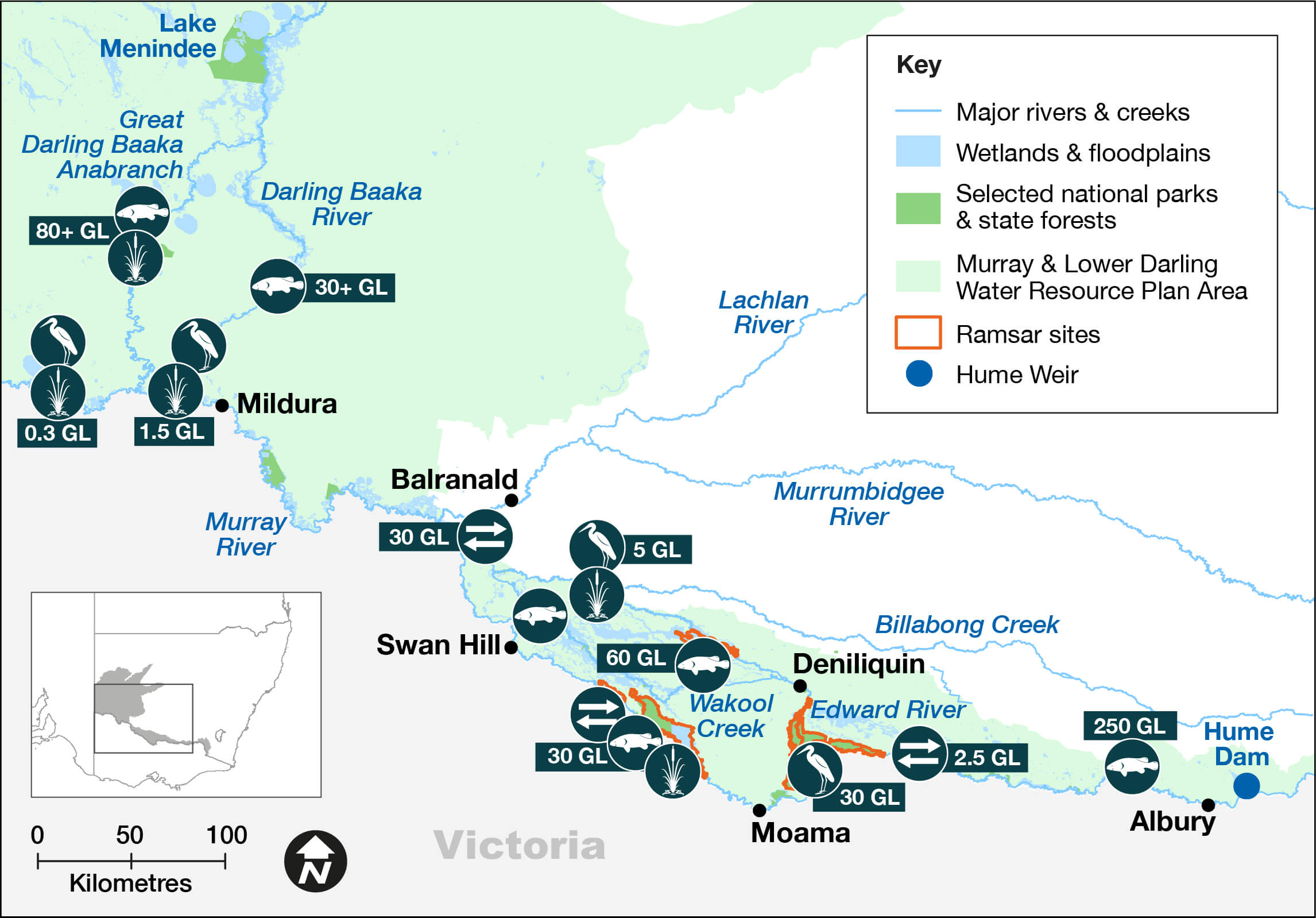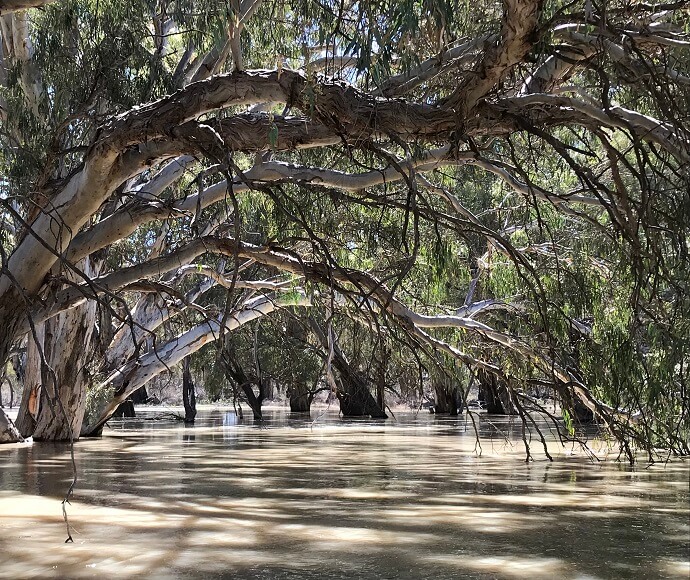The Murray and Lower Darling Baaka catchments cover 98,300 square kilometres and include the world’s largest stand of river red gums and Australia’s longest river, the Murray. Ramsar-listed sites include the Millewa, Werai and Koondrook–Perricoota forests, Chowilla Floodplain and River Murray Channel.
Prior to the 2018–19 fish kills, the Lower Darling Baaka River supported one of the Basin’s most robust Murray cod populations and was an important flow corridor for golden perch.
The Murray and Lower Darling Baaka catchments’ wetlands and rivers support important Aboriginal cultural values, with more than 968 cultural sites formally recorded. Aboriginal people continue to contribute important knowledge to inform the management of water for the environment. The Traditional Owners of the Murray Lower Darling Baaka are the Wiradjuri, Dhudhuroa, Waywurru, Bangerang, Barapa Barapa, Wamba Wamba, Yorta Yorta, Barkindji, Maraura, Muthi Muthi, Nyeri Nyeri, Tati Tati, Wadi Wadi and Weki Weki (Central Murray). Barkindji, Maraura, Muthi Muthi, Nyeri Nyeri, Ngintait, Barkindji and Maraura (Lower Darling).
Water for rivers and wetlands
In 2022–23, managed water will target a range of outcomes, including:
- flow regimes that support the nationally threatened Australasian bittern and southern bell frog
- improved conditions for small-bodied native fish
- connectivity, refuge and dispersal flows for large-bodied native fish
- support for floodplain ecosystems, including the Central Murray Forest Ramsar site (Millewa, Werai and Koondrook-Perricoota).
The Lower Darling Baaka River and Great Darling Anabranch received a mix of natural high flows and environmental flows over winter, spring and summer 2021–22, providing good conditions for the recovery of native fish populations. Environmental water managers worked collaboratively with other agencies and the community to coordinate the delivery of releases. These interventions will contribute to improving native fish populations in the Murray–Darling Basin.
Weather and water forecast
The El Niño–Southern Oscillation (ENSO1) outlook remains at La Nina, with a return to neutral ENSO during winter. Even as La Niña weakens, it will continue to influence global weather and climate. La Niña events increase the chances of above average rainfall across large parts of eastern Australia during Autumn.
Water managers have prepared watering plans that consider a range of weather and water availability scenarios. This is known as resource availability scenario planning. As of April 2022, ‘moderate’ or ‘wet to very wet’ conditions are forecast for the Murray and Lower Darling Baaka catchments in 2022–23.
1. ENSO: The interaction between the sea surface and atmosphere over the Pacific Ocean which results in dryer or wetter conditions (El Nino or La Nina).
Resource availability scenario
Current forecast: Moderate or wet to very wet
| Conditions | Main aim | Other aims |
|---|---|---|
| Very dry | Protect | Avoid critical loss Maintain key refuges Avoid catastrophic events |
| Dry | Maintain | Maintain river functioning Maintain key functions of high priority wetlands |
| Moderate | Recover | Improve ecological health and resilience Improve opportunities for plants and animals to breed, move and thrive |
| Wet to very wet | Enhance | Restore key floodplain and wetland linkages Enhance opportunities for plants and animals to breed, move and thrive |
Key planned actions for 2022–23
Waterbirds
Water managers have planned:
- watering events for the Murray catchment national and regional parks to support sites that contain nesting Australasian bitterns and other native waterbirds. Australasian bitterns are an important story-telling species for Aboriginal people.
- deliveries of up to 1 gigalitre (GL) for Lake Agnes to promote waterbird breeding for threatened species such as blue-billed ducks
- deliveries up to 3 GL for Pollack Swamp which is a breeding site for egrets, herons, and little bitterns.
Native fish
Water managers have planned Murray River multi-site flows from Hume Dam to South Australia to support native fish and instream productivity.
Fish flows in the Edward-Wakool system will provide benefits for native fisheries, instream vegetation and food webs.
Water managers have planned a winter–spring flow for the Lower Darling Baaka River to support native fish recruitment. There is potential for a continuation of flow down the Great Darling Anabranch to the Murray River, water volumes permitting.
Vegetation
Water managers will deliver flows to private wetlands, providing critical habitat for southern bell frogs. Supporting the condition of remnant woodlands and other floodplain vegetation communities produces essential carbon and nutrients to support the aquatic food web and provides habitat and corridors for wildlife such as the nationally threatened superb parrot.
Connectivity
Flows will provide connectivity between Tuppal Creek and the Edward River, Cunninyeuk, Murrain Yarrein and Cockran-Jimaringle creeks and the Niemur, Wakool rivers and Yarrein Creek.
A cultural flow is planned in the Koondrook-Perricoota Forest. This will also benefit vegetation, woodland birds and waterbirds.

Map of proposed annual priority targets in the Murray and Lower Darling Baaka Water Resource Plan area 2022–23
The Department of Planning and Environment (the department) is supporting the health and resilience of rivers and wetlands by delivering water for the environment where and when it is needed. We use the best available science, management expertise and experience to manage water across the landscape. This statement of annual priorities identifies the waterways and wetlands that are likely to receive water.
Our decision-making process considers:
- expected availability of water in the coming year
- conditions of the previous year
- current health of the plants and animals in these ecosystems.
Community-based Environmental Water Advisory Groups (EWAGs) provide feedback and advice to the department on the management of water for the environment.
The NSW Government works with the Commonwealth Environmental Water Holder to manage water in the catchment.
Water for the environment is a share of the water in dams and rivers that is set aside to support the long-term health of local rivers, creeks and wetlands. Healthy rivers carry water to homes, farms, schools and businesses. Rivers and wetlands are important cultural and spiritual sites for Aboriginal people, as well as the broader community.
Planned environment water
| Source | Maximum volume available (gigalitres) | Volume expected 1 July under current conditions (gigalitres) |
|---|---|---|
| Barmah–Millewa Forest environmental water allocation (BMF EWA) ^ | 700 gigalitres (up to 100 gigalitres is available annually to NSW and Victoria) | Current balance 198 gigalitres |
| Murray additional environmental water allowance (MAA) | 29 gigalitres available to NSW only | 5.7 gigalitres |
| River Murray Increased Flow | Up to 70 gigalitres available annually to NSW and Victoria in the Snowy Hydro system. Availability of RMIF in Hume is dependent on releases of RMIF from the Snowy Hydro system | 56 gigalitres currently forecast for 1 July 2022 based on SCBEWC decision on RMIF call |
Water licenced to New South Wales
| Source | Maximum volume available (gigalitres) | Volume expected 1 July under current conditions (gigalitres) |
|---|---|---|
| Murray – conveyance | 30 gigalitres | 18.5 gigalitres based on forecast 30% GS allocation |
| Murray – high security | 2.8 gigalitres | 2.7 gigalitres based on forecast 97% HS allocation |
Water licenced to the Commonwealth
| Source | Maximum volume available (gigalitres) | Volume expected 1 July under current conditions (gigalitres) |
|---|---|---|
| Murray – general security (GS) ** | 369.6 gigalitres | 110.9 gigalitres based on forecast 30% GS allocation |
| Murray – high security (HS) | 17.9 gigalitres | 17.3 gigalitres based on forecast 97% HS allocation |
| Murray – conveyance | 20.2 gigalitres | 12.5 gigalitres based on forecast 30% GS allocation |
| Lower Darling – general security (GS) | 21.6 gigalitres | 21.6 gigalitres based on forecast 100% GS allocation |
| Lower Darling – high security (HS) | 4.2 gigalitres | 4.2 gigalitres based on forecast 100% HS allocation |
NSW water licenced to The Living Murray (MDBA)
| Source | Maximum volume available (gigalitres) | Volume expected 1 July under current conditions (gigalitres) |
|---|---|---|
| Murray – general security (GS) ** | 83 gigalitres (100% entitlement) | 24.9 gigalitres based on forecast 30% allocation |
| Murray – high security (HS) | 5.1 gigalitres | 4.9 gigalitres based on forecast 97% HS allocation |
| Lower Darling – general security (GS) | 47.8 gigalitres | 47.8 gigalitres based on forecast 100% GS allocation |
| Lower Darling – high security (HS) | 0.5 gigalitres | 0.5 gigalitres based on forecast 100% HS allocation |
Note: This is an indicative summary of expected volumes to be available. For further detail and information on available volumes please contact the region via Department of Planning and Environment enquiries on 1300 361 967.
^ The maximum volume of BMF EWA is 100 gigalitres per year shared equally between NSW and Victoria. The maximum accrued volume of BMF EWA is 700 gigalitres. BMF EWA is only available for environmental use when the NSW Murray general security allocation reaches 30 per cent or 50 per cent under exceptional circumstances.
** Murray general security has carryover provisions. Carryover has not been included in the Murray general security licences in the table. The carryover component will need to be considered separately, with carryover + allocations limited to 110% of the share components.

The Murray and Lower Darling Baaka catchments cover 98,300 square kilometres.
More about...
- Long-term water plans
- Water Sharing Plan for the NSW Murray and Lower Darling Regulated Rivers Water Sources
- Murray Darling Basin Authority
- Murray Darling Basin Plan
- Commonwealth Environmental Water Office - Lower Murray Darlingopens a new window
- Commonwealth Environmental Water Office - Mid Murray
- The Living Murray Annual Environmental Watering Plan 2013-14opens a new window
More information on planned and past watering events
- Murray and Lower Darling Baaka Catchments – Water for the Environment: Annual Priorities 2021–22
- Murray and Lower Darling catchments: Annual environmental watering priorities 2020-21
- Murray and Lower Darling: Annual environmental watering priorities 2019-20
- Murray and Lower Darling catchments: Annual Environmental Watering Priorities 2018-19
- Murray and Lower Darling catchment: Annual environmental watering priorities 2017-18
- Murray and Lower Darling Water Resource Plan Area: Statement of annual environmental watering priorities 2016–17
- Murray and Lower Darling Valleys Annual Environmental Watering Plan 2014-2015
- Water for environment outcomes 2021-22
- Use of water for the environment in NSW: Outcomes 2020–21
- Use of water for the environment in NSW: Outcomes 2019–20
- Use of water for the environment in NSW: Outcomes 2018–19
- Use of water for the environment in NSW: Outcomes 2017–18